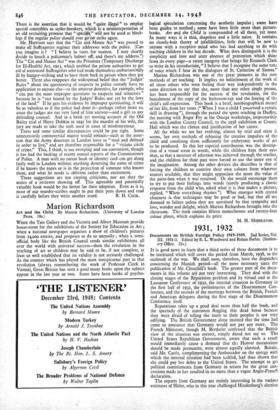Marion Richardson
WHEN the Tate Gallery and the Victoria and Albert Museum provide house-room for the exhibitions of the Society for Education in Art ; when a national newspaper organises a show of children's pictures from 14,000 entries, and proposes to do so annually ; when a semi- official body like the British Council sends similar exhibitions all over the world with universal success—then the revolution in the teaching of art to children may be said to be, if not complete, at least so well established that its validity is not seriously challenged. As the country which has played the most conspicuous part in that revolution (always remembering the work of Professor Cizek in Vienna), Great Britain has seen a good many books upon the subject appear in the last year or two. Some have been books of psycho-. logical speculation concerning the aesthetic impulse ; some have been guides to .method ; some have been little more than picture- books. An and the Child is compounded of all these, yet none. In many ways it is thin, shapeless and a little naive. It contains no closely-knit theory of infallibilities, little that will be new to anyone with a receptive mind who has had anything to do with teaching children in the last decade. What does distinguish it is the simplicity and love and utter absence of pretention which shine from its every page—a sweet integrity that brings Sir Kenneth Clark to write in his introduction I believe that I recognise the same' tone of voice which I hear in th ." e dialogues of. St. Catherine of Sienna."
Marion Richardson was one of the great pioneers in the new methods of art teaching. It implies no belittlement of the work of all those others who were feeling their way independently in the same direction to say that she, more than any other single person, has been responsible for the success of the revolution, for • the banishment of the copy of the bathroom-tap and the freeing of the child's self-expression. This book is a brief, autobiographical record of her life, from her teens (" When I was a child I possessed a certain skill in drawing "), through the period she spent teaching in Dudley, the meeting with Roger Fry at the Omega workshops, inspectorship with the London County Council, to the 1938 exhibition at County Hall which was the climax and justification of her career.
All the while we see her evolving, almost by trial and error it seems, her own methods of releasing the creative impulses of the child and canalising them sufficiently for embryonic works of art to be produced. In this her especial contribution was the descrip- tion of a. visual scene in words, while the children kept their eyes shut, so that a measure of selection was achieved through the teacher, and,the children for their part were forced to use the-inner eye of the imagination. Among the other devices she describes is that of forcing the children to contrive their own colours from whatever sources available, that they might appreciate the more the value of the paint-box when it was returned. Or she would encourage them to try to put their feelings into words (surely producing a classic response from the child who, asked what it is that makes a picture, replied, " When everything rhymes "). What emerges with crystal clearness is that techniques may be good or bad, but that all are doomed to failure unless they are sustained by that sympathy and love, wonder and delight, which Marion Richardson brought into the classroom. The book contains fifteen monochrome and twenty-four colour plates, which explains its price.
M. H. MIDDLETON.


































 Previous page
Previous page